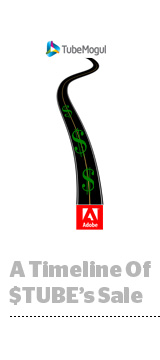 Adobe might have won TubeMogul’s hand in marriage, but there were several other strategic acquirers involved in the courtship.
Adobe might have won TubeMogul’s hand in marriage, but there were several other strategic acquirers involved in the courtship.
According to a US Securities and Exchange Commission (SEC) filing dated Nov. 18, TubeMogul’s sales process really began last November.
Up until the time Adobe agreed to acquire the DSP in mid-November, 16 entities – including three private equity/investment firms – were considered strategic buyers for the video platform.
Those 16 narrowed to eight, then narrowed down again to four in the final bidding stage.
Here’s a bit of the backstory, along with AdExchanger’s educated guess on some of Tube’s suitors.
November 2015: The acquisition flame is lit after shareholders had a strategic planning meeting about TubeMogul’s future. The board recommended CEO Brett Wilson explore meetings with potential acquirers that would fit strategically.
June 23, 2016: TubeMogul met with bankers from Morgan Stanley to discuss which companies might pursue a transaction.
Aug. 18: One financial sponsor, outlined as “Party A” in Tube’s Schedule 14D-9, owned a relevant portfolio company and requested a meeting with TubeMogul.
Aug. 29: A representative from “Party B,” a media company, also wanted to meet up with TubeMogul.
Around the same time, Wilson ran into an Adobe rep at a “social event” and talked potential opportunities for a sale. No surprise here – the two companies had long explored a deepening of their partnership.
Sept. 15: Enter “Party C,” “a foreign telecom company,” according to the filing, that expressed interest in partnering with or acquiring TubeMogul. Could it be Singapore telecom Singtel, a company the ad tech industry quietly noted has demand-side platform dreams? It’s worth noting Singtel, via its venture arm, pumped $10 million into TubeMogul in 2013.
Sept. 23: Morgan Stanley meets with a representative from a “social media company” identified as “Party D” and described as having a “strong strategic fit” with TubeMogul in its SEC filing. It’s not far-fetched to assume that Facebook, which is doubling down on video and has an existing partnership with Tube, saw the opportunity. Same goes for Twitter.
Sept. 24: Morgan Stanley contacts an Adobe representative about a potential acquisition of TubeMogul. Adobe runs the transaction idea by senior management internally to gauge the level of interest.
Sept. 26: Wilson plays a bit of hardball with social media company “Party D,” explaining that others are evaluating TubeMogul. “Party D,” however, might not be able to move as quickly because of other priorities.
Sept. 28: Things are starting to get more serious with Adobe. Adobe reps meet with Wilson in San Francisco and the two companies outline areas for a strategic match within Adobe’s digital marketing business.
Sept. 30: Media company “Party B” meets with Wilson to “discuss joint opportunities and synergies.”
Sept. 28-Oct. 3: Morgan Stanley dials up Adobe’s corp-dev team to discuss status and timing on the process. Things are graduating to the next level.
Oct. 3: The foreign telecom “Party C” reiterates to Wilson it has consistently heard positive things about TubeMogul, and would do further due diligence.
Morgan Stanley encourages the telecom to make a move in the coming weeks. (TubeMogul’s board wanted bidders to make their final offer by Nov. 1.) The telecom responds that it would be tough to move quickly and meet the proposed timeline.
Oct. 19: After a few weeks of discussion and entering into nondisclosure agreements, Adobe EVP Brad Rencher and other Adobe digital marketing honchos video conference with Wilson, another TubeMogul rep and Morgan Stanley. A detailed briefing commences.
Oct. 24-28: Social media company “Party D” is still in the game. They meet with Morgan Stanley and TubeMogul to discuss possible deal synergies. Financial firm “Party A” does the same.
Nov. 1: The financial sponsor, “Party A,” issues a bid for TubeMogul for $12 per share in an all-cash transaction.
Nov. 2: Adobe’s senior execs head to TubeMogul’s Emeryville, Calif., headquarters the next day for final discussion. Later that day, Morgan Stanley informed TubeMogul that Adobe had issued a proposal that was “seller friendly.”
Morgan Stanley informed Adobe that other bidders were involved and to act quickly (and to offer at least $13 per share to be competitive).
Nov. 4: Morgan Stanley indicates that TubeMogul would enter exclusive negotiations with Adobe in return for a written offer outlining a definitive agreement to acquire the company by Nov. 9 at $14 per share.
Nov. 10: After a few more meetings, the two companies sign a merger/tender and support agreement, and the rest – as they say – is history.
TubeMogul declined to comment for this story.
The order and depiction of these events has been condensed and edited.













